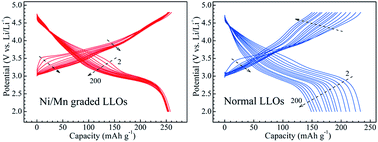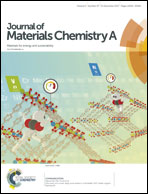Mitigating the capacity and voltage decay of lithium-rich layered oxide cathodes by fabricating Ni/Mn graded surface†
Abstract
Lithium-rich layered oxides (LLOs) deliver a high energy-density of above 1000 W h Kg−1 owing to new charge/discharge mechanisms and are regarded as up-and-coming cathodes for next-generation lithium-ion batteries (LIBs). However, they usually suffer from serious capacity and voltage decay during repeated cycles, limiting their wider practical applications. Herein, Ni/Mn-graded LLOs, in which the nickel content increases gradually, while the manganese content decreases continuously at the outer surface of secondary particles, were rationally designed and further prepared by a modified co-precipitation route combined with solid-state reactions. As expected, this Ni/Mn-graded LLOs exhibited a higher reversible capacity of 290.9 mA h g−1, much improved stability of the capacity and voltage, ∼90% capacity retention, and a high voltage of 3.23 V (vs. Li/Li+), even after 200 cycles, compared with the normal LLOs. XPS and XRD characterization of the cycled electrodes indicated that these enhanced electrochemical properties are probably ascribed to the nickel-increased surface, which suppresses the structural transitions from layered to spinel, and/or the rock-salt phases as well as the side-reactions on the electrode/electrolyte interface. In particular, this Ni/Mn-graded structure opens up a feasible and effective tactic to mitigate the capacity and voltage decay of LLOs and could possibly promote the process of their practical application in high-energy LIBs.



 Please wait while we load your content...
Please wait while we load your content...